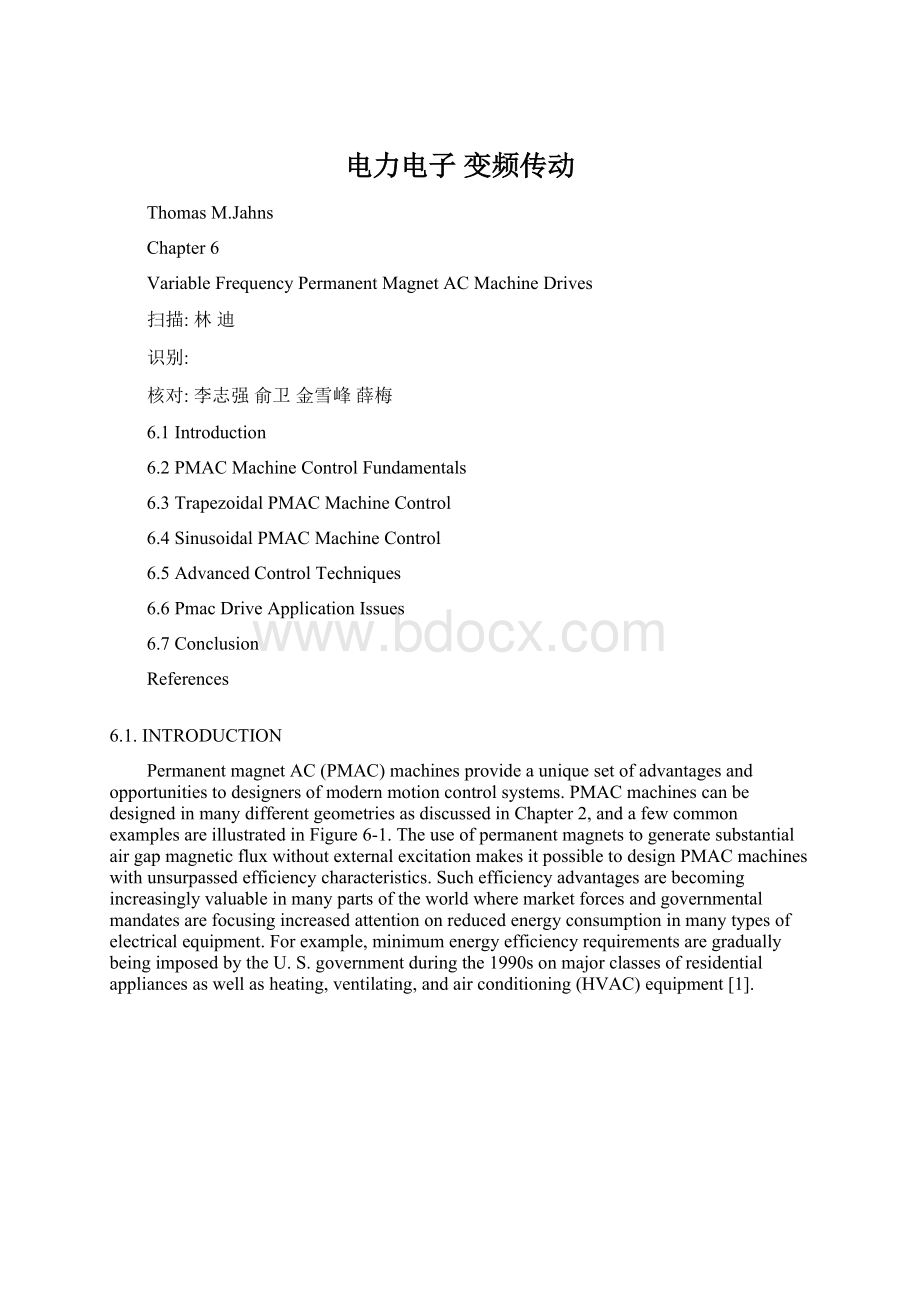电力电子 变频传动.docx
《电力电子 变频传动.docx》由会员分享,可在线阅读,更多相关《电力电子 变频传动.docx(53页珍藏版)》请在冰豆网上搜索。

电力电子变频传动
ThomasM.Jahns
Chapter6
VariableFrequencyPermanentMagnetACMachineDrives
扫描:
林迪
识别:
核对:
李志强俞卫金雪峰薛梅
6.1Introduction
6.2PMACMachineControlFundamentals
6.3TrapezoidalPMACMachineControl
6.4SinusoidalPMACMachineControl
6.5AdvancedControlTechniques
6.6PmacDriveApplicationIssues
6.7Conclusion
References
6.1.INTRODUCTION
PermanentmagnetAC(PMAC)machinesprovideauniquesetofadvantagesandopportunitiestodesignersofmodernmotioncontrolsystems.PMACmachinescanbedesignedinmanydifferentgeometriesasdiscussedinChapter2,andafewcommonexamplesareillustratedinFigure6-1.TheuseofpermanentmagnetstogeneratesubstantialairgapmagneticfluxwithoutexternalexcitationmakesitpossibletodesignPMACmachineswithunsurpassedefficiencycharacteristics.Suchefficiencyadvantagesarebecomingincreasinglyvaluableinmanypartsoftheworldwheremarketforcesandgovernmentalmandatesarefocusingincreasedattentiononreducedenergyconsumptioninmanytypesofelectricalequipment.Forexample,minimumenergyefficiencyrequirementsaregraduallybeingimposedbytheU.S.governmentduringthe1990sonmajorclassesofresidentialappliancesaswellasheating,ventilating,andairconditioning(HVAC)equipment[1].
Alternatively,thelowlossesmadepossiblebytheappropriateapplicationofpermanentmagnetscanbeusedtoachievemachinedesignswithimpressivelyhighvaluesofpowerdensityandtorque-to-inertia(Te/J)ratios[2].ThesecharacteristicsmakePMACmachineshighlyattractiveformanyactuatorandservoapplicationsthatdemandthefastestpossibledynamicresponse.
Ontheotherhand,PMACmachinespresentspecialchallengestotheelectricalequipmentdesignersincetheyaresynchronousmachinesthat,intheabsenceofauxiliaryrotorwindings,absolutelyrequireaccompanyingpowerelectronicsforoperation.ThedriveelectronicsisnecessarytoperfectlysynchronizetheACexcitationfrequencywiththerotationalspeedasaprerequisiteforgeneratingusefulsteady-statetorque,incontrasttoaninductionmotorwhichtypicallyoperatesfromafixedfrequencyACsource(50or60Hz).Asaresult,PMACmachinesareparticularlywellsuitedtomotioncontrolapplicationsthatcanjustifythecostofthepowerelectronicstotakeadvantageoftheuniquelyattractiveefficiencyanddynamicresponsecharacteristicsprovidedbythistypeofmachine.
Theobjectiveofthischapteristoreviewtheprincipalmotioncontroltechniquesthathavebeendevelopedsincethe1970sforPMACmachinedrives.TwomajorclassesofPMACmachines—trapezoidalandsinusoidal—wereintroducedinChapter2thathavesomenotabledifferencesintheirrespectivecontrolrequirementsandperformancecharacteristics.AmajorportionofthischapterwillbedevotedtoadiscussionofthecommonalitiesanddifferencesassociatedwiththecontrolofthesetwoimportantfamiliesofPMACmachines.ThespecialcontrolrequirementsofPMACmachinestoachieveextendedspeedoperatingrangesusingflux-weakeningtechniqueswillalsobeaddressed.
TheparticularrequirementsofPMACmachinesforsynchronizationoftheexcitationwaveformswithrotationalspeedhavegivenrisetoaconsiderablevarietyofcontroltechniquesforeliminatingtheshaft-mountedpositionsensorthatwillbereviewedlaterinthischapter.ThisdiscussionofadvanceddrivecontroltechniqueswillbefollowedbyacomparisonofthestrengthsandweaknessesofPMACmachinedrivescomparedtoothermajorcompetingmachinedrivetechnologies.ThechapterwillconcludewithsummarydescriptionsofseveralPMACmachinedrivesystemsthathavebeenselectedtoillustratethebreadthoffieldedapplications,leadingtoaclosingdiscussionofexpectedfuturetrends.
6.1.1.Background
PMACmachinedrivesrepresenttheconvergenceofatleasttwodistinctthreadsofpermanentmagnetmachinedevelopment.Oneofthesethreadsistheearlydevelopmentofline-startPMACmotorswithembeddedrotorsquirrelcagewindingsdesignedforoperationdirectlyfromutility-suppliedACpower.WorkonthisspecialclassofhybridPMACinductionmachinedatesbacktothe1950s[3,4]usingAlnicomagnets.Thesemachineswerewidelyappliedinsomeimportantindustrialapplicationssuchastextilemanufacturinglinesthatrequirelargenumbersofmachinesoperatingatidenticalspeeds[5].
Laterduringthe1970s,considerableresearchattentionwasfocusedonimproveddesignsforline-startPMACmachinesasameansofachievingsignificantenergysavingsinindustrialapplications.Integralhorsepowerversionsoftheseline-startPMACmotorshavebeendevelopedwithimpressiveefficiencycharacteristicsusingbothferriteandrare-earthmagnets[6],buttheirresultingmanufacturingcostpremiumsoverconventionalinductionmachinespreventedwidemarketacceptance.Nevertheless,significanttechnicalprogresshasbeendemonstratedinthedevelopmentofthesehigh-powerPMACmachines,andworkinthisareacontinuestoday[7].
Representingthesecondthreadofdevelopment,permanentmagnetDC(PMDC)servomotorsbegantodisplaceconventionalwound-fieldDCmotorsinhigh-performancemachinetoolservoapplicationsinthe1960swhensolid-stateDCchoppercircuitsreachedmarketmaturity[8].Theavailabilityofhigh-strengthrareearthpermanentmagnetsmadeitpossibletodevelopcompactfast-responsePMDCservomotors[9]withoutthesteady-statelossesandadditionalcircuitcomplicationsassociatedwithtraditionalwound-fieldDCmachines.
Finally,inthe1970s,thesetwodevelopmentpathsconvergedasPMACmachines(withoutrotorcages)werecombinedwithadjustablefrequencyinverterstoachievehigh-performancemotioncontrol[10].ThisapproachhadthedesirableeffectofeliminatingthedualdisadvantagesofhighrotorinertiaandbrushwearassociatedwithPMDCmotorcommutators.Theclassof"brushlessDCmotors"usingtrapezoidalPMACmotorswasdevelopedfirst[11]inordertotakeadvantageofthecontrolsimplificationsthatareachievablewiththisconfiguration,asdiscussedinmoredetailinSection6.3.Thishasbeenfollowedbytheevolutionofhigh-performancesinusoidalPMACmachinedrivesduringthelate1970sand1980swhichhavebeenmadepossiblebytherapidadvancesindigitalreal-timecontrolhardwareandvectorcontroltechnologyfirstappliedtoinductionmotors[12].
6.1.2.MotionControlPerformanceRequirements
AlthoughseveralofthebasicissuesassociatedwithmachinedrivespecificationswereintroducedinChapter2,afewkeypointswillbebrieflyreviewedhereinordertosetthestageforthefollowingdiscussionofPMACmachinecontroltechniques.Torque-speedenveloperequirementsforPMACmachinedrivestypicallyfallintooneoftwoclassesillustratedinFigure6-2."Constanttorque"applicationsarecharacterizedbythesquaretorque-speedenvelopeshowninFigure6-2awhichrequiresthatmaximumtorque
beavailableatallspeedsuptothemaximumrotorspeed
.Actuatorsandservosystemsaretypicalexamplesofconstanttorqueapplicationswhichrelyonmaximumtorqueavailabilityatallspeedstoensuremaximumdynamicresponse.PMACmachinesarenaturallywellsuitedforconstanttorqueapplicationsbecauseoftheconstantlevelofmagneticfluxdeliveredbytherotorpermanentmagnetstothemachine'sairgap.
Incontrast,"constanthorsepower"applicationsarecharacterizedbyatorque-speedenvelopewhichfollowsahyperbolicconstantpowertrajectory(Te-ωr=P0=constant)overawidespeedrangeabovebasespeedωbasillustratedinFigure6-2b.Oneofthemostfamiliarexamplesofaconstanthorsepowerapplicationiselectricvehicletractionthatrequireshightorqueforlow-speedaccelerationandreducedtorqueforhigh-speedcruising.ConstanthorsepoweroperationposesspecialchallengesforPMACmachinessincethereisnofieldwindingwhichcanbedirectlyweakenedasinaconventionalseparatelyexcitedDCmotor.However,"flux-weakening"controltechniquesareavailableforPMACmachinesthatcanachievethesameeffect,asdescribedlaterinthischapter.
Althoughtheprecedingdiscussionhasbeenframedintermsofsingle-quadrantmotoringoperationwithpositivetorqueandpositivespeed,manyapplicationsrequirethatthePMACmachinedevelopbrakingtorqueforcontrolleddecelerationandthatthemachinebeabletorotateinbothdirections.Suchrequirementsgiverisetotwo-andfour-quadranttorque-speedoperatingenvelopesasdiscussedpreviouslyinChapter2.ThePMACmachineiswellsuitedforsuchapplicationssinceitcanoperateequallywellasamotororgenerator,anddirectionofrotationhasnoimpactonthemachine'sperformancecharacteristics.
PMACmachinedriveapplicationscanbefurthercharacterizedfromacontrolstandpointbythenatureoftheprimarycontrolvariable.Thethreeprincipaltypesofdrivecontrolconfigurationsaretorquecontrol,speedcontrol,andpositioncontrol.Torquecontrolrepresentsthemostbasiccontrolrequirements,typifiedbytheacceleratorandbrakepedalsofanelectricvehicledrive.Manyotherindustrialandcommercialapplicationssuchaspumpsandprocesslinesrequirespeedcontrol,representinganintermediatelevelofcontrolperformancerequirements.Finally,positioncontrolsystemsgiverisetosomeofthemostdemandingmotioncontrolrequirementsforhigh-performanceapplicationssuchasmachinetoolservos.Motioncontrolperformancerequirementsarealsoreflectedindynamicresponsespecifications.Forexample,dynamicresponserequirementsforaPMACspeed-orposition-controlledservosystemaretypicallyexpressedintermsofbandwidthspecificationswhichdefinetheabilityofthedrive'soutputshafttofaithfullytracksinuso